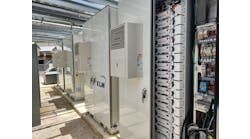PXiSE System to Balance On-Site Power at Green Hydrogen Plant in Western Australia
Yokogawa Australia will supply an energy management system (EMS) for the initial phase of the Yuri Green Hydrogen Project in Western Australia.
The Yuri Green Hydrogen Project, an industrial-scale renewable hydrogen production facility located in Pilbara, will include an 18-MW solar plant, an 8-MW battery energy storage system (BESS) and a 10-MW electrolyzer.
The project is a joint venture between ENGIE Renewables Australia and Mitsui, and Monford Group, an engineering, procurement, construction and commissioning consortium, is building the complex.
The EMS provided by Yokogawa was developed by PXiSE Energy Solutions, a microgrid controller and software developer that was acquired by Yokogawa Electric in 2021. The software will control the solar plant, BESS and the electrolyzer, allowing the facility’s renewable energy production to be managed autonomously.
“In a world in which systems are becoming closely integrated, based on the system of systems (SoS) concept, we will contribute to our customer’s ESG management by offering high value-added solutions, including the integration of plant control and energy management systems to enable the timely control of complex power systems,” said Koji Nakaoka, senior vice president and head of Yokogawa’s energy and sustainability business headquarters and global sales headquarters.
Green hydrogen will be used to produce green ammonia
The complex is expected to produce up to 640 tons of green hydrogen power each year. The clean fuel will be used as feedstock to produce green ammonia at the adjacent ammonia plant owned by Yara Pilbara Fertilizer. Yara is a large nitrogen-based mineral fertilizer producer.
Ammonia production is a highly energy-intensive process, accounting for around 2% of total global energy consumption each year, according to the International Energy Agency. Green ammonia, which reduces the carbon emissions associated with the fertilizer production process, can be made with green hydrogen.
Green hydrogen, also known as clean or renewable hydrogen, is considered by many to be the clean fuel of the future. Renewable energy sources such as wind and solar are used to separate hydrogen from water via electrolysis in a process that produces zero carbon emissions – the only byproduct is water.
Other hydrogen production methods, such as those used to produce gray or blue hydrogen, are less environmentally friendly. Both gray and blue hydrogen are produced by breaking down fossil fuels such as natural gas with carbon dioxide being a byproduct. Gray hydrogen is the least climate friendly as carbon emissions are typically vented unabated into the environment. Blue hydrogen is considered low carbon, as most emissions are captured and stored underground.
PXiSE is well-established in Western Australia
PXiSE is well-known in the Western Australia energy space. The company’s distributed energy resources management systems software was successfully deployed by Horizon Power at a microgrid in the remote Western Australia community of Onslow, prompting the utility to roll out the technology at 34 additional microgrid sites.
Track news on microgrid projects. Subscribe to the free Microgrid Knowledge Newsletter.







